Discover 12 hidden attractions, cool sights, and unusual things to do in Bhutan. Don't miss out on these must-see attractions: Punakha Dzong (Punakha), Paro Taktsang (Paro) or Rinpung Dzong (Paro).
Below, you can find the list of the most amazing places you should visit in Bhutan.
Table of Contents
Punakha Dzong, Punakha
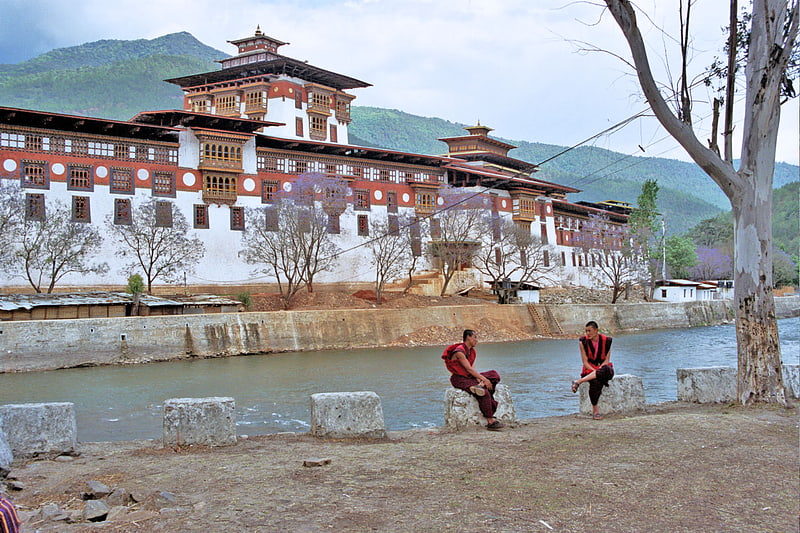
Riverside palace from the 17th century. The Punakha Dzong, also known as Pungthang Dewa chhenbi Phodrang, is the administrative centre of Punakha District in Punakha, Bhutan. Constructed by Ngawang Namgyal, 1st Zhabdrung Rinpoche, in 1637–38, it is the second oldest and second-largest dzong in Bhutan and one of its most majestic structures. The dzong houses the sacred relics of the southern Drukpa Lineage of the Kagyu school of Tibetan Buddhism, including the Rangjung Kharsapani and the sacred remains of Ngawang Namgyal and the tertön Pema Lingpa.
Punakha Dzong was the administrative center and the seat of the Government of Bhutan until 1955 when the capital was moved to Thimphu. It is listed as a tentative site in Bhutan's Tentative List for UNESCO inclusion.[1]
Paro Taktsang, Paro
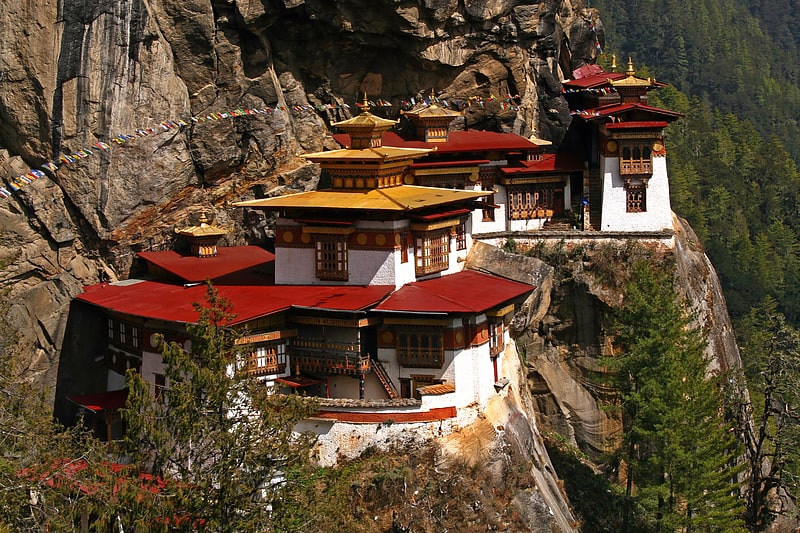
Cliffside monastery with storied caves. Paro Taktsang, is a sacred Vajrayana Himalayan Buddhist site located in the cliffside of the upper Paro valley in Bhutan. It is one of thirteen Tiger's Nest caves in historical Tibet in which Padmasambhava practiced and taught Vajrayana.
A later monastery complex was built in 1692, around the Taktsang Senge Samdup cave, where Guru Padmasambhava meditated and practiced with students including Yeshe Tsogyal before departing the kingdom of Tibet in the early 9th century. Padmasambhava is credited with introducing Vajrayana Buddhism to Bhutan, which was then part of Tibet, and is the tutelary deity of the country. Today, Paro Taktsang is the best known of the thirteen taktsang or "tiger lair" caves in which he and his students meditated.
The shrine dedicated to Padmasambhava, also known as Gu-ru mTshan-brgyad Lhakhang or "the Shrine of the Guru with Eight Names", refers to Padmasambhava's Eight Manifestations and is an elegant structure built around the cave in 1692 by Gyalse Tenzin Rabgye. It has become the cultural icon of Bhutan. A popular festival, known as the Tsechu, held in honor of Padmasambhava, is celebrated in the Paro valley sometime during March or April.[2]
Rinpung Dzong, Paro
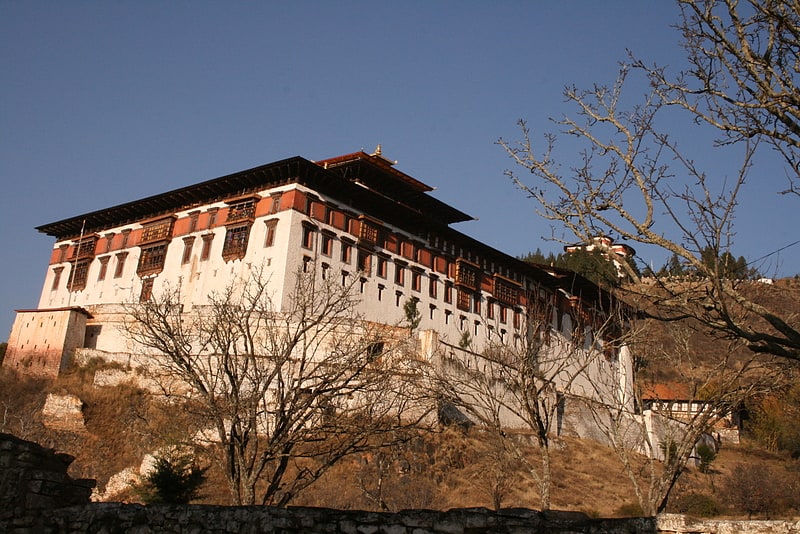
Monastery. Rinpung Dzong is a large dzong - Buddhist monastery and fortress - of the Drukpa Lineage of the Kagyu school in Paro District, Bhutan. It houses the district Monastic Body and government administrative offices of Paro Dzongkhag. It is listed as a tentative site in Bhutan's Tentative List for UNESCO inclusion.[3]
National Museum of Bhutan, Paro
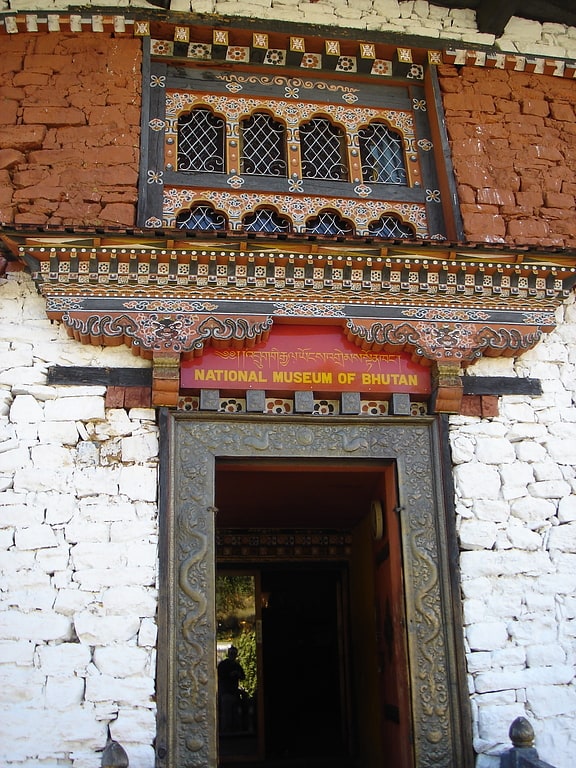
Also known as: ལྟ་རྫོང་།
Museum in Paro, Bhutan. National Museum of Bhutan is a cultural museum in the town of Paro in western Bhutan. Established in 1968, in the renovated ancient Ta-dzong building, above Rinpung Dzong under the command of His Majesty, the King Jigme Dorji Wangchuck, the third hereditary Monarch of Bhutan. The necessary infrastructure was created to house some of the finest specimens of Bhutanese art, including masterpieces of bronze statues and paintings. Suitable galleries were constructed to house the extensive collections. Works of art were elegantly displayed on scientific lines.
Today the National Museum has in its possession over 3,000 works of Bhutanese art, covering more than 1,500 years of Bhutan's cultural heritage. Its rich holdings of various creative traditions and disciplines, represent a remarkable blend of the past with the present and is a major attraction for local and foreign visitors.[4]
Simtokha Dzong, Thimphu
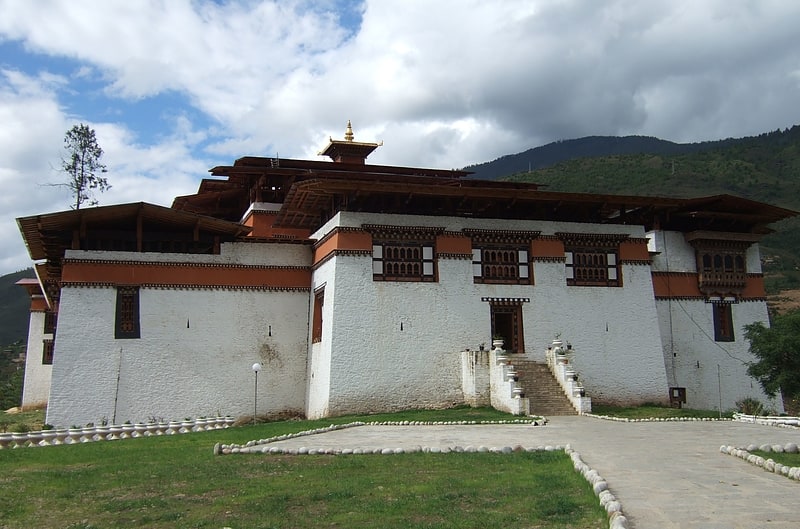
Also known as: སེམས་རྟོགས་ཁ་རྫོང་།
Fortress in Semtokha, Bhutan. Simtokha Dzong also known as Sangak Zabdhon Phodrang is a small dzong. It was built in 1629 by Zhabdrung Ngawang Namgyal, who unified Bhutan. It is the first of its kind built in Bhutan. An important historical monument and former Buddhist monastery, today it houses one of the premier Dzongkha language learning institutes. It recently underwent renovation.[5]
Memorial Chorten, Thimphu
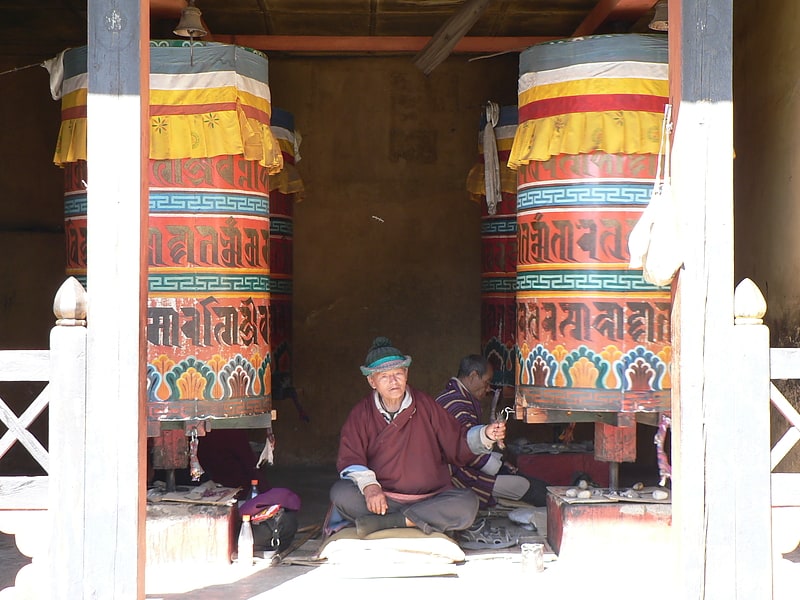
Landmark stupa with a golden spire. The Memorial Stupa, Thimphu, also known as the Thimphu Chorten, is a stupa in Thimphu, Bhutan, located on Doeboom Lam in the southern-central part of the city near the main roundabout and Indian military hospital. The stupa, built in 1974 to honor the third Druk Gyalpo, Jigme Dorji Wangchuck, is a prominent landmark in the city with its golden spires and bells. In 2008, it underwent extensive renovation. It is popularly known as "the most visible religious landmark in Bhutan". It was consecrated by Dudjom Jigdral Yeshe Dorje.
This stupa is unlike others as it does not enshrine human remains. Only the Druk Gyalpo’s photo in a ceremonial dress adorns a hall in the ground floor. When he was alive, Jigme Dorji wanted to build "a chorten to represent the mind of the Buddha".[6]
Dechen Phodrang Monastery, Thimphu

Monastery. Dechen Phrodrang. meaning "Palace of Great Bliss". is a Buddhist monastery in Thimphu, Bhutan. It is located to the north of the city.
In 1971 it became a monastic school and currently it has 450 student monks enrolled in eight-year courses with a staff of 15. The monastery contains a number of important historical Bhutanese artifacts including 12th century paintings monitored by UNESCO and a noted statue of Shabdrung Ngawang Namgyal on the upper floor. In the downstairs chapel, there is a central Sakyamuni Buddha.[7]
Chimi Lhakhang, Punakha
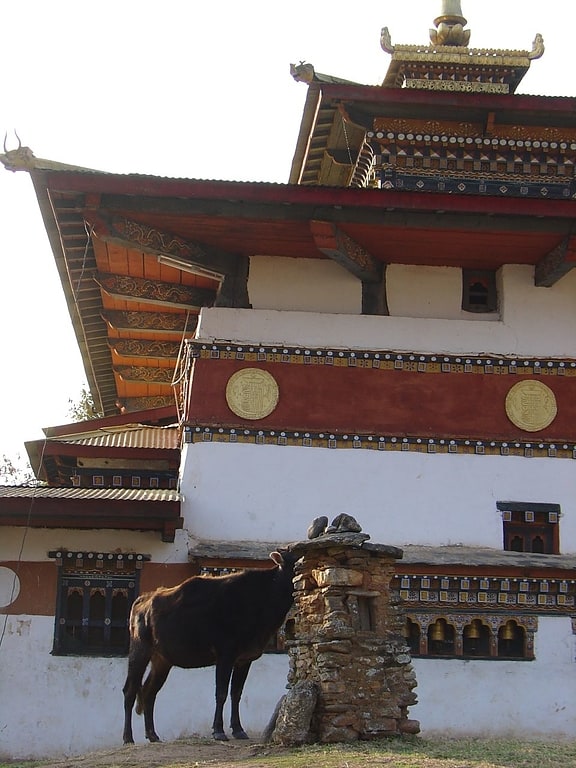
Monastery in Bhutan. Chimi Lhakhang, also known as Chime Lhakhang or Monastery or temple, is a Buddhist monastery in Punakha District, Bhutan. Located near Lobesa, it stands on a round hillock and was built in 1499 by the 14th Drukpa hierarch, Ngawang Choegyel, after the site was blessed by the "Divine Madman" the maverick saint Drukpa Kunley who built a chorten on the site.
In founding the site it is said that Lama Kunley subdued a demon of Dochu La with his “magic thunderbolt of wisdom” and trapped it in a rock at the location close to where the chorten now stands. He was known as the "Mad Saint" or “Divine Madman” for his unorthodox ways of teaching Buddhism by singing, humour and outrageous behaviour, which amounted to being bizarre, shocking and with sexual overtones. He is also the saint who advocated the use of phallus symbols as paintings on walls and as flying carved wooden phalluses on house tops at four corners of the eaves. The monastery is the repository of the original wooden symbol of phallus that Kunley brought from Tibet. This wooden phallus is decorated with a silver handle and is used to bless people who visit the monastery on pilgrimage, particularly women seeking blessings to beget children. The tradition at the monastery is to strike pilgrims on the head with a 10-inch (25 cm) wooden phallus (erect penis). Traditionally symbols of an erect penis in Bhutan have been intended to drive away the evil eye and malicious gossip.[8]
Pedestrian suspension bridge behind the dzong, Punakha
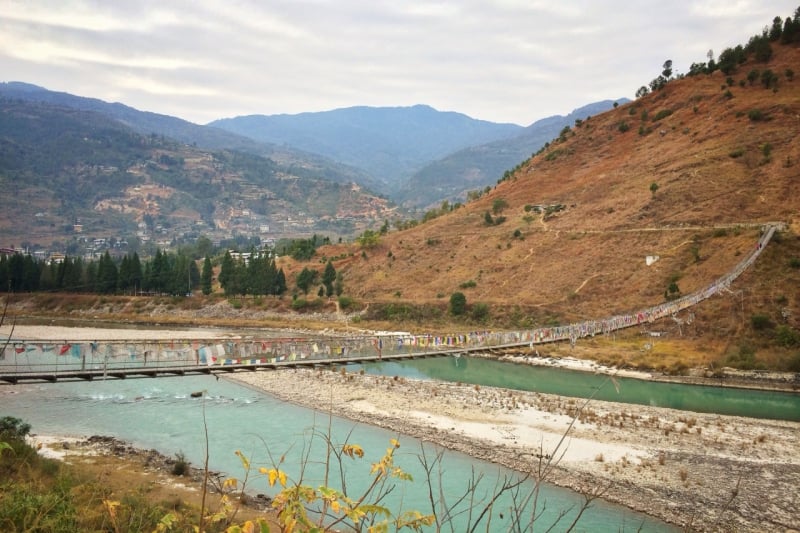
Bridge
Address: Punakha Dzong, 13001 Punakha
Tango Monastery, Jigme Dorji National Park
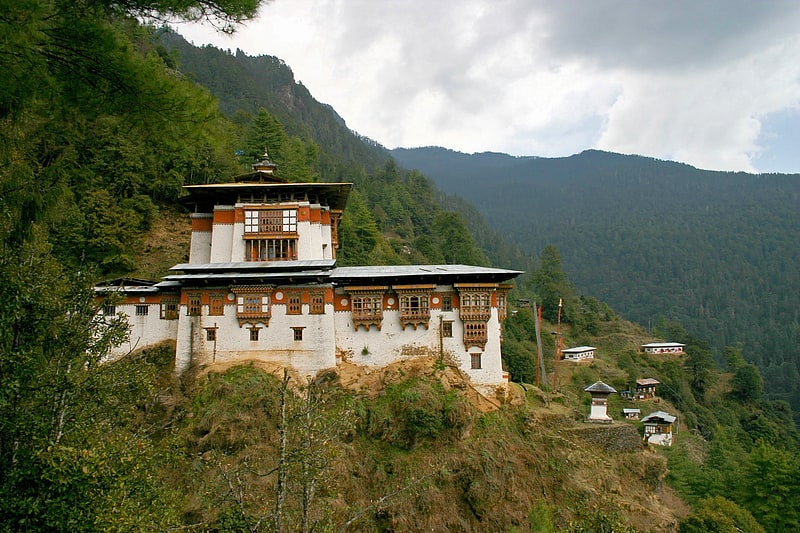
Also known as: རྟ་མགོ།
Monastery in Bhutan. The Tango Monastery is a Buddhist monastery located 14 kilometres to the north of the capital city of Thimphu in Bhutan, near Cheri Mountain. It was founded by Phajo Drugom Zhigpo in the 13th century and built in its present form by Tenzin Rabgye, the 4th Temporal Ruler in 1688. In 1616, the Tibetan lama Shabdrung Ngawang Namgyal meditated in its cave. The self-emanated form of the wrathful Hayagriva is deified in the monastery. It belongs to the Drukpa Kagyu School of Buddhism in Bhutan.[9]
Chagri Monastery, Jigme Dorji National Park
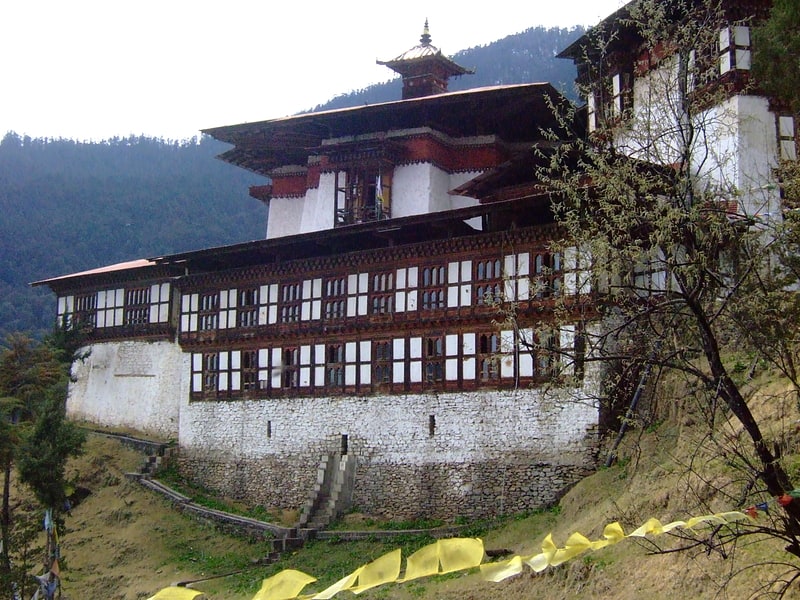
Chagri Dorjeden Monastery, also called Cheri Monastery, is a Buddhist monastery in Bhutan established in 1620 by Ngawang Namgyal, 1st Zhabdrung Rinpoche, the founder of the Bhutanese state.
The monastery, which is now a major teaching and retreat center of the Southern Drukpa Lineage of the Kagyu school of Tibetan Buddhism, is located at the northern end of the Thimphu Valley about 15 kilometres (9.3 mi) from the capital. It sits on a hill above the end of the road at Dodeyna and it takes about an hour to walk up the steep hill to reach the monastery from there.
According to Bhutanese religious histories, the place was first visited by Padmasambhava in the 8th century. In the 13th century it was visited by Phajo Drugom Zhigpo the Tibetan Lama who first established the Drukpa Kagyu tradition in Bhutan. Johnsingh (2005) describes the beauty of the place and the occurrence of goral there.
Chagri Dorjeden was the first monastery established in Bhutan by Ngawang Namgyal in 1620 when he was 27 years old. The Zhabdrung spent three years in strict retreat at Chagri and resided there for many periods throughout the rest of his life. It was at Chagri in 1623 that he established the first Drukpa monastic order in Bhutan.
In 1705, the 7th Druk Desi, Umze Peljor, retired to Chagri Monastery, where he lived until his death in 1707.[10]
Mount Jitchu Drake, Jigme Dorji National Park

Mountain in Bhutan. Jichu Drake is a mountain in Bhutan among the Himalayas, and a companion peak to Mount Jomolhari. Its height is given variously as 6714m, 6789m, 6797m, 6970m or 6989m by various sources. Jitchu Drake has a double summit, with the lower summit to the south.
Jitchu Drakye is the Tutelary deity of Paro and its environs. It is also known as Kungphu or Ts(h)erim Kang, Shumkang, Jichi Dak Keth (meaning ‘sparrow rock sound’), Tseringegang or Tsheringme Gang (snows of the goddess of long life.
A local story is that the double peak originated because Jitch Drake teased a young girl while she was weaving, resulting in her hitting Jitchu Drake on the head with the tham (the piece of wood used to beat a new line of weft weaved), producing the double peak.
Latest edition: Bart Jordans - Trekking in Bhutan 2018 Cicerone Press[11]